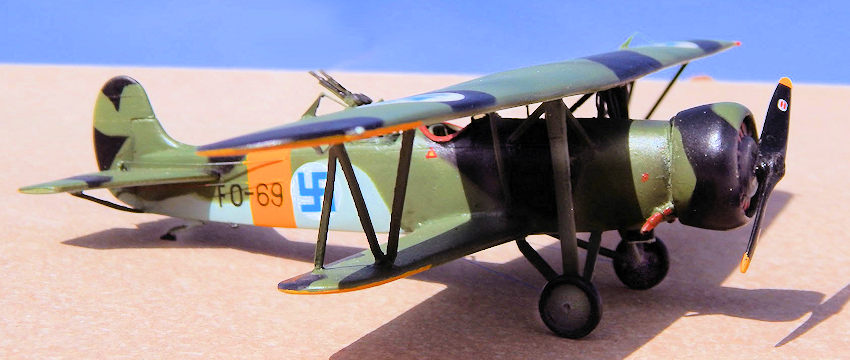
Airmodel 1/72 Fokker C.V-E
| KIT #: | ? |
| PRICE: | 13 Euros |
| DECALS: | None provided |
| REVIEWER: | Carmel J. Attard |
| NOTES: | Vacuform kit with resin details |

| HISTORY |
The Fokker C.V was designed by Anthony Fokker’s team and was the logical successor to his earlier C.IV of 1924. This Fokker design was a cantilever-wing two-seat biplane of fabric-skimmed tubular-construction fuselage basically related to the earlier CIV, with a fined-down fuselage and fuel tanks installed in the upper wing. It was a new reconnaissance aircraft design, popular and progressive type for its time of pre war years. It was accepted as a standard by several air forces and widely built abroad under licence to become the most used of all Fokker military designs, in several operational roles.
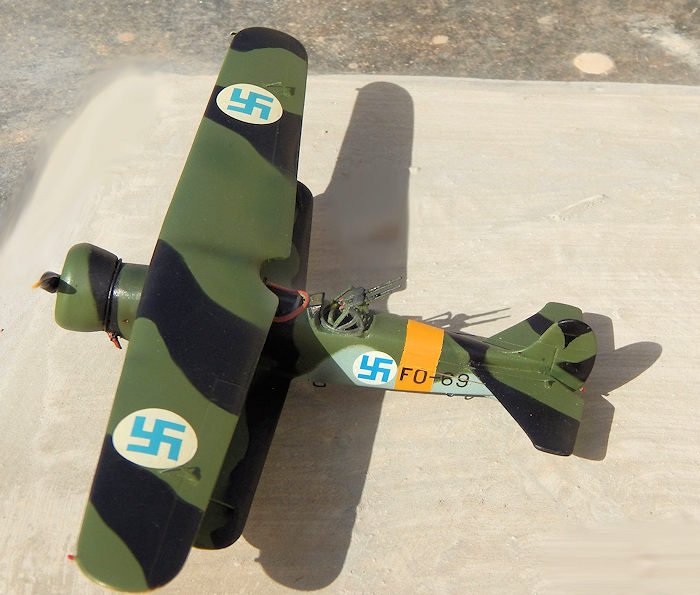 The C.V was the device of Fokker to
evolve a machine, which would meet a variety of military requirements with
maximum efficiency. The aim was achieved by the novel feature of designing and
producing several different sets of wings, which could be changed in less than
an hour. Emphasis were also placed on interchangeability of power plant, and
engines ranging in power from 250hp to 500hp could be mounted or changed in
about an hour by a skilled team. This scheme gave the C.V the ability to serve
as a tactical or strategic reconnaissance machine or a light bomber as required
to the needs of the moment.
The C.V was the device of Fokker to
evolve a machine, which would meet a variety of military requirements with
maximum efficiency. The aim was achieved by the novel feature of designing and
producing several different sets of wings, which could be changed in less than
an hour. Emphasis were also placed on interchangeability of power plant, and
engines ranging in power from 250hp to 500hp could be mounted or changed in
about an hour by a skilled team. This scheme gave the C.V the ability to serve
as a tactical or strategic reconnaissance machine or a light bomber as required
to the needs of the moment.
Over the period of its early use,
three distinctive variants appeared designated C.V-A, C.V-B and C.V-C.
Performance figures of these versions depended on the power plant installed,
which included engines by Lorraine-Dietrich, BMW and Hispano-Suiza. The C.V-A
was a tactical-reconnaissance type with one or two fixed and two ring-mounted
machine guns. Besides the Dutch Army Air Corps, the type was purchased by
sever\l air arms. These included Bolivian AF the type of which was fitted with
600hp Hispano-Suiza engines. There was also an American version with a small
cockpit and side panels and a floatplane version built in Holland but the
project was never developed with any success experiencing landing problems. The
Swedish floatplane version was more successful, designated S-6H with a new
rudder, Another version was the C.V-D and C.V-E which featured tapering wings
and used as a reconnaissance type and training machines, The two types could be
distinguished easi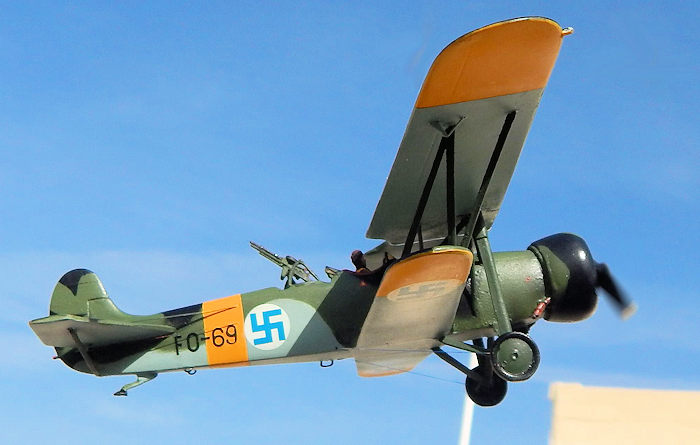 ly by their wing struts layout. The –D having ‘V’ interplane
struts and the –E having ‘N’ struts.
ly by their wing struts layout. The –D having ‘V’ interplane
struts and the –E having ‘N’ struts.
The standardisation of fuselage allowed the installation of all-liquid or air-cooled engines in the 350hp to 650hp range. Besides the types mentioned earlier, other engines as Rolls Royce F10, BMW Va and IV, Jupiter, Hornet, Wasp and Armstrong Siddeley Jaguar could be fitted. The latter were in particular demand in large numbers in Denmark, Hungary, Finland, Sweden, Norway, Italy and Switzerland that were widely built under licence.
In 1934 a rejuvenated variant of the C.V-E was produced. This was powered by a 730hp Bristol Pegasus 11M-2 with Townsend ring. In due course other variants appeared with different engines installed and 30 aircraft being licence built in Denmark and registered R-22 to R-52. By 1940 only 10 aircraft were in service with the Danish Aviation troops. Two of these, R-23 and R-42 were flown by the Luftwaffe with the codes 3W+NO and 3W+OD, the latter machine was returned to Denmark in 1947, having miraculously survived the war. Twenty C.Vs that were found by the Germans in various Danish hangars were renovated and sent to Russia in 1943, their fate is not recorded.
| THE KIT |
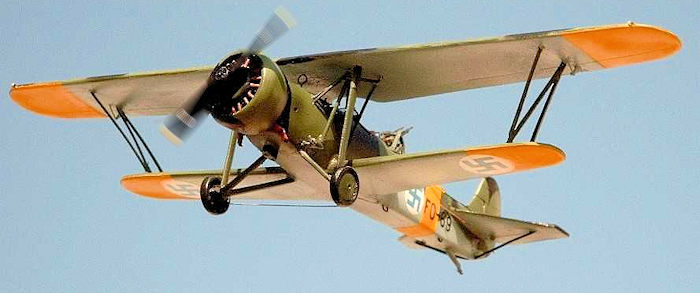 The kit, which is issued in a sealed
bag by Airmodel Products, Germany is a vac-form type and mainly consists of two
sheets in white styrene that contains the main wings and fuselage vac-parts.
Included in the pack are resin detail parts such as the radial engine,
propeller, wheels, and machine guns and there is an exploded diagram showing the
placement of all of these items. Four different plan views give camouflage
details for a Finn AF machine in black and green camouflage, a Luftwaffe one in
splinter type standard camouflage as well as two metal finished Danish C.V-E-34
and C.V-E-33.
The kit, which is issued in a sealed
bag by Airmodel Products, Germany is a vac-form type and mainly consists of two
sheets in white styrene that contains the main wings and fuselage vac-parts.
Included in the pack are resin detail parts such as the radial engine,
propeller, wheels, and machine guns and there is an exploded diagram showing the
placement of all of these items. Four different plan views give camouflage
details for a Finn AF machine in black and green camouflage, a Luftwaffe one in
splinter type standard camouflage as well as two metal finished Danish C.V-E-34
and C.V-E-33.
| CONSTRUCTION |
All kit parts are first cut, sanded
and shaped to conform to drawings. There are two different types of tail planes
and one decides at an early stage which type one wants to build with respect to
the markings selected. Some research was required to add detail to cockpit
interior. I selected a version used by the
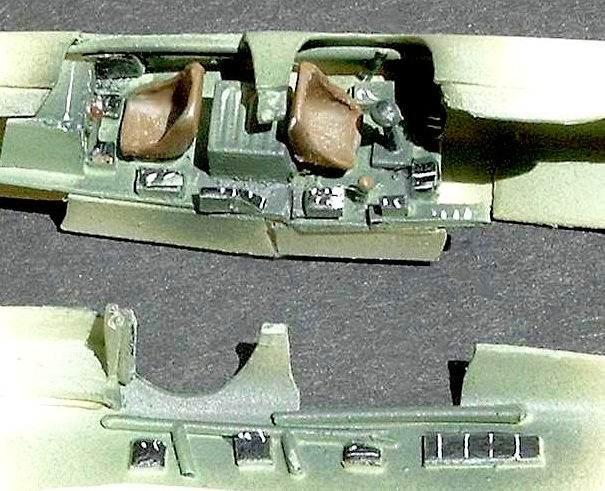 Finn Air Force, this had a Townsend
ring mounted radial engine. The ring is made out of two parts, a shallow forward
ring and a deeper rear one that are joined together. The detailed resin engine
fitted inside. As one would expect the resin parts, which had flush required
careful cleaning using Exacto blade. Parts are brittle and can easily break if
handled roughly.
Finn Air Force, this had a Townsend
ring mounted radial engine. The ring is made out of two parts, a shallow forward
ring and a deeper rear one that are joined together. The detailed resin engine
fitted inside. As one would expect the resin parts, which had flush required
careful cleaning using Exacto blade. Parts are brittle and can easily break if
handled roughly.
Suring construction I went the extra step and added detail to the kit as follows: I detailed crew compartments, pilot and gunner station. Surface detail on fuselage and wing parts was minimal apart from that of control surfaces and reference to photos from aircraft books and on line offered help. Once the kit parts are shaped the assembly is straight forward and other small detail added including the wing tip lights, wheel leg rigging to fuselage, foot step and hand grip at rear made out of steel wire, shortened exhausts, added under wing fuel pipe attachment, aileron link and actuators, a pair of ring mounted machine guns, connecting wires to elevators and rudder light. I made use of a gig from stiff card to hold wing parts in place when fixing the upper wings to the fuselage struts until these set firm in position.
| COLORS & MARKINGS |
One may paint the model before the upper wing is fixed in place and that can simplify matters in most cases. I followed the kit painting plans to airbrush the model in medium green and black camouflage on the upper surfaces and light blue to lower surfaces. Decals were picked from my spares box. Model was finally given a coat of varnish to give it an overall sheen finish.
| CONCLUSIONS |
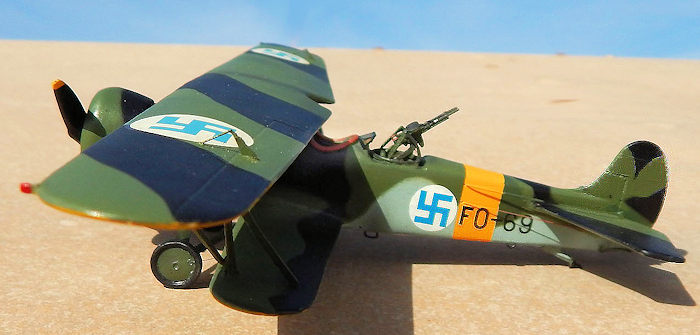 I have enjoyed building yet another
vac kit and was delighted with the end result filling yet another gap in my Finn
AF section. The early days of WWII are a popular theme and this aircraft, the
C.V-E played a role in the service with the Finn AF circa 1944. Still I go by
what once Neville Duke who was Hawker chief test pilot on the Hawker Hunter he
once wrote and I quote:
I have enjoyed building yet another
vac kit and was delighted with the end result filling yet another gap in my Finn
AF section. The early days of WWII are a popular theme and this aircraft, the
C.V-E played a role in the service with the Finn AF circa 1944. Still I go by
what once Neville Duke who was Hawker chief test pilot on the Hawker Hunter he
once wrote and I quote:
“ Models of almost any description have an absorbing fascination for everyone. Those already fortunate enough to have discovered this hobby attain a vast pride in the making, and a satisfaction in the finished article, which cannot be understood by those as yet unenlightened or unawakened to the art.”
24 November 2016
Copyright ModelingMadness.com If you would like your product reviewed fairly and fairly quickly, please
contact
the editor or see other details in the
Note to
Contributors. Back to the Main Page
Back to the Review
Index Page Back to the Previews Index Page